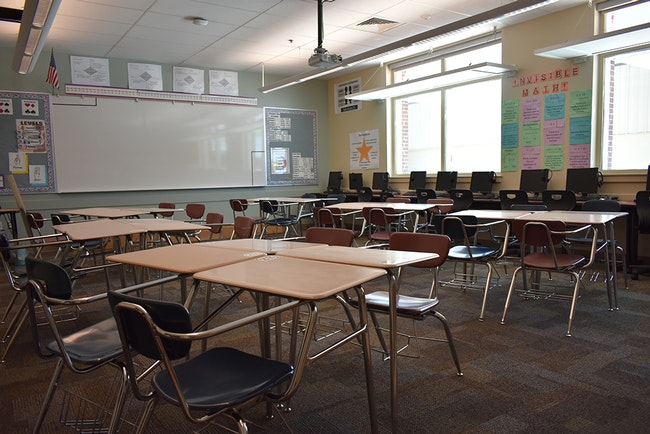
Schools will have to provide for social distancing in the fall in classrooms such as this one at Ontario Middle School. (The Enterprise/Rachel Parsons)
VALE – School administrators across Malheur County are digging into extensive rules issued by the state last week that will govern how schools will operate in the fall.
The state gave districts just two months to devise their plans.
One major issue for each school system is where students will go. The state is allowing choices of in-person classes at school buildings, continued distance learning from home, or some combination. Depending on the choice, school officials have to decide how long school days will be, how many students can be handled safely in a classroom, and how to move students who rely on buses that no longer can be filled.
“It’s definitely a big haul,” said Nikki Albisu, superintendent of the Ontario School District.
Mark Redmond, superintendent of the Malheur Education Service District, said it will take days for school officials to digest the state mandates. He said school will look different from district to district.
“From Vale on down, they are going to have kids in school as much as possible,” Redmond said. “For Ontario or Nyssa, they’re bigger, so that is a tougher task.”
Albisu can tick off the challenges, noting her school system already had to pivot to a new school model in the spring. That’s when Gov. Kate Brown ordered schools closed and education officials later directed the school year be closed out with remote learning.
“We are really going to have to step out of our own heads and step away from the educational systems that we are used to,” she said in a statement. “We are going to have to think creatively and thoughtfully as we move forward.”
The biggest challenge is getting schools up and running while not increasing the risk that employees or students will get infected with the coronavirus.
The state, for instance, is requiring that students be spaced six feet apart in classrooms, meaning some classes can host fewer students. Albisu said that mandate will be especially challenging for Ontario High School, which has about 700 students.
“Time and health-related resources are some of our biggest challenges,” Albisu said.
She said getting enough supplies may be difficult, from personal protective equipment required of teachers and other staff to cleaning supplies such as hand sanitizer.
In Vale, Superintendent Alisha McBride briefed the school board last week on the challenges, explaining that there may be enough room in schools to host on-site teaching again.
She said that “safety has to be a priority” but she is considering the on-site model.
“My goal is to get some direction from by board of directors regarding which model they would like to see and start engaging my staff, parents and even secondary students and community members regarding which model they’d like to see,” McBride said.
“Transportation is one of the challenges we are going to have to address,” she said. “We are going to have to look and do some calculations to determine how many buses we have, how many drivers we have and how many students ride. It is a key piece.”
Chelle Robbins, superintendent of Four Rivers Charter School in Ontario, said social distancing for younger students is “our biggest concern.”
She said the school uses tables instead of desks for students in kindergarten through fifth grade.
Darren Johnson, superintendent of the Nyssa School District, said he hopes schools in the district will reopen onsite, but that a secondary plan would involve a hybrid model.
“We’re not interested in doing the distance learning,” Johnson said. “We just didn’t feel like that was right for kids. It’s not the best thing for them.”
Nyssa plans to follow the state’s recommendation of maintaining three feet of distance between passengers on school buses, he said. How the district will manage not being able to fit the same number of students on a bus as usual is currently being discussed, and potential options include running extra routes, asking parents to drive children or send vans to pick up children.
Johnson’s concerns about reopening in the fall are the financial impact “from an economy that’s been shut down,” keeping employees and doing right by the students, he said.
The toughest challenges for the Nyssa district include communicating health and safety protocol to families, “trying to address everyone’s concerns,” staff adjusting to new schedules and budgeting for increased hand-washing stations, hand sanitizer and other resources.
Relying on conflicting guidance, he said the school district allowed student athletes to practice on school grounds in a limited capacity with temperature monitoring and restrictions in place once summer break began.
He said he subsequently learned that state orders still prohibit such activities until June 30 and the school district has since suspended them.
News tip, information or question about schools? Contact reporter Aidan McGloin by email at [email protected].
PLEASE SUPPORT OUR CONTINUING SERVICE TO THE COMMUNITY
SUBSCRIBE – $5 a month, automatically.
DONATE – to provide additional support. You can also mail a check: Malheur Enterprise, PO Box 310 Vale OR 97918. Donor identities are confidential unless the donor specifies otherwise. Thank you!




